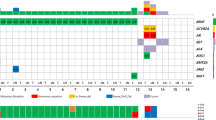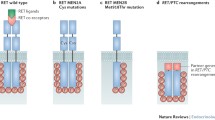Abstract
Introduction
BRAF mutations and RET or NTRK1 rearrangements were identified as causing events that drive the malignant transformation of the thyroid follicular cell. The impact of these alterations on the course of papillary thyroid carcinoma (PTC) is still unsettled.
Patients and methods
Tumor tissues of 290 (98 male, 192 female) patients were intra-operatively snap frozen or harvested from archival paraffin-embedded blocks and used for extraction of DNA and RNA. Comprehensive analysis of RET/PTC and NTRK1 rearrangements was carried out by multiplex screening RT-PCR, hybrid-specific RT-PCR and sequencing of detected hybrids. A mutation-specific PCR was used for BRAF analysis.
Results
The BRAF V600E mutation was detected in 122/290 (42%), RET rearrangements in 20/137 (14.6%), and NTRK1 rearrangements in 15/93 (16.1%) PTCs. One hundred forty one out of 290 (48.6%) PTCs demonstrated none of the genetic alterations studied. Eight PTCs expressed two different mutations (1 RET/PTC + BRAF, 6 NTRK1 + BRAF, 1 RET/PTC + NTRK1). Tumor-specific survival analysis (mean follow-up, 5.5 years) demonstrated no significant difference, but a tendency toward worse prognosis of BRAF-positive patients compared to BRAF-negative patients or rearrangement-positive patients, respectively.
Conclusion
Long-term follow-up data on large tumor panels are needed to disclose significant survival differences of prognostic predictors on PTC. This study provides further evidence that patients harboring BRAF-V600E-positive PTCs may experience an unfavorable course of the disease compared to patients with tumors carrying other genetic alterations.


Similar content being viewed by others
References
Basolo F, Giannini R, Monaco C et al (2002) Potent mitogenicity of the RET/PTC3 oncogene correlates with its prevalence in tall-cell variant of papillary thyroid carcinoma. Am J Pathol 160:247–254
Durante C, Puxeddu E, Ferretti E et al (2007) BRAF mutations in papillary thyroid carcinomas inhibit genes involved in iodine metabolism. J Clin Endocrinol Metab 92:2840–2843
Elisei R, Ugolini C, Viola D et al (2008) BRAF(V600E) mutation and outcome of patients with papillary thyroid carcinoma: a 15-year median follow-up study. J Clin Endocrinol Metab 93:3943–3949
Espadinha C, Santos JR, Sobrinho LG et al (2009) Expression of iodine metabolism genes in human thyroid tissues: evidence for age and BRAFV600E mutation dependency. Clin Endocrinol 70:629–635
Fugazzola L, Puxeddu E, Avenia N et al (2006) Correlation between B-RAFV600E mutation and clinico-pathologic parameters in papillary thyroid carcinoma: data from a multicentric Italian study and review of the literature. Endocr-Relat Cancer 13:455–464
Guan H, Ji M, Bao R et al (2009) Association of high iodine intake with the T1799A BRAF mutation in papillary thyroid cancer. J Clin Endocrinol Metab 94:1612–1617
Henderson YC, Shellenberger TD, Williams MD et al (2009) High rate of BRAF and RET/PTC dual mutations associated with recurrent papillary thyroid carcinoma. Clin Cancer Res 15:485–491
Ito Y, Yoshida H, Maruo R et al (2009) BRAF mutation in papillary thyroid carcinoma in a Japanese population: its lack of correlation with high-risk clinicopathological features and disease-free survival of patients. Endocr J 56:89–97
Kebebew E, Weng J, Bauer J et al (2007) The prevalence and prognostic value of BRAF mutation in thyroid cancer. Ann Surg 246:466–470, discussion 470-461
Kim SK, Song KH, Lim SD et al (2009) Clinical and pathological features and the BRAF(V600E) mutation in patients with papillary thyroid carcinoma with and without concurrent Hashimoto thyroiditis. Thyroid 19:137–141
Lee JH, Lee ES, Kim YS (2007) Clinicopathologic significance of BRAF V600E mutation in papillary carcinomas of the thyroid: a meta-analysis. Cancer 110:38–46
Lee X, Gao M, Ji Y et al (2009) Analysis of differential BRAF(V600E) mutational status in high aggressive papillary thyroid microcarcinoma. Ann Surg Oncol 16:240–245
Lima J, Trovisco V, Soares P et al (2004) BRAF mutations are not a major event in post-Chernobyl childhood thyroid carcinomas. J Clin Endocrinol Metab 89:4267–4271
Lupi C, Giannini R, Ugolini C et al (2007) Association of BRAF V600E mutation with poor clinicopathological outcomes in 500 consecutive cases of papillary thyroid carcinoma. J Clin Endocrinol Metab 92:4085–4090
Moses W, Weng J, Khanafshar E et al (2010) Multiple genetic alterations in papillary thyroid cancer are associated with younger age at presentation. J Surg Res 160:179–183
Musholt PB, Imkamp F, Von Wasielewski R et al (2003) RET rearrangements in archival oxyphilic thyroid tumors: new insights in tumorigenesis and classification of Hurthle cell carcinomas? Surgery 134:881–889, discussion 889
Musholt TJ, Musholt PB, Khaladj N et al (2000) Prognostic significance of RET and NTRK1 rearrangements in sporadic papillary thyroid carcinoma. Surgery 128:984–993
Oler G, Cerutti JM (2009) High prevalence of BRAF mutation in a Brazilian cohort of patients with sporadic papillary thyroid carcinomas: correlation with more aggressive phenotype and decreased expression of iodide-metabolizing genes. Cancer 115:972–980
Park SY, Park YJ, Lee YJ et al (2006) Analysis of differential BRAF(V600E) mutational status in multifocal papillary thyroid carcinoma: evidence of independent clonal origin in distinct tumor foci. Cancer 107:1831–1838
Pierotti MA, Vigneri P, Bongarzone I (1998) Rearrangements of RET and NTRK1 tyrosine kinase receptors in papillary thyroid carcinomas. Recent Results Cancer Res 154:237–247
Riesco-Eizaguirre G, Rodriguez I, De La Vieja A et al (2009) The BRAFV600E oncogene induces transforming growth factor beta secretion leading to sodium iodide symporter repression and increased malignancy in thyroid cancer. Cancer Res 69:8317–8325
Salvatore G, Chiappetta G, Nikiforov YE et al (2005) Molecular profile of hyalinizing trabecular tumours of the thyroid: high prevalence of RET/PTC rearrangements and absence of B-raf and N-ras point mutations. Eur J Cancer 41:816–821
Santoro M, Papotti M, Chiappetta G et al (2002) RET activation and clinicopathologic features in poorly differentiated thyroid tumors. J Clin Endocrinol Metab 87:370–379
Sapio MR, Posca D, Raggioli A et al (2007) Detection of RET/PTC, TRK and BRAF mutations in preoperative diagnosis of thyroid nodules with indeterminate cytological findings. Clin Endocrinol 66:678–683
Sapio MR, Posca D, Troncone G et al (2006) Detection of BRAF mutation in thyroid papillary carcinomas by mutant allele-specific PCR amplification (MASA). Eur J Endocrinol 154:341–348
Tallini G, Santoro M, Helie M et al (1998) RET/PTC oncogene activation defines a subset of papillary thyroid carcinomas lacking evidence of progression to poorly differentiated or undifferentiated tumor phenotypes. Clin Cancer Res 4:287–294
Tang KT, Lee CH (2010) BRAF mutation in papillary thyroid carcinoma: pathogenic role and clinical implications. J Chin Med Assoc 73:113–128
Author information
Authors and Affiliations
Corresponding author
Additional information
No potential conflicts of interest to be announced
Rights and permissions
About this article
Cite this article
Musholt, T.J., Schönefeld, S., Schwarz, C.H. et al. Impact of pathognomonic genetic alterations on the prognosis of papillary thyroid carcinoma. Langenbecks Arch Surg 395, 877–883 (2010). https://doi.org/10.1007/s00423-010-0682-6
Received:
Accepted:
Published:
Issue Date:
DOI: https://doi.org/10.1007/s00423-010-0682-6




